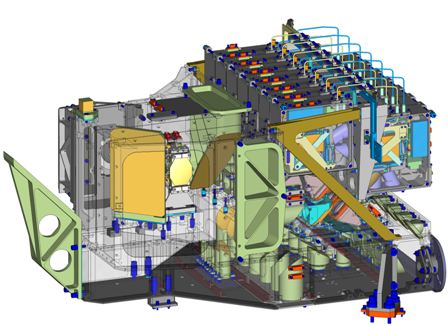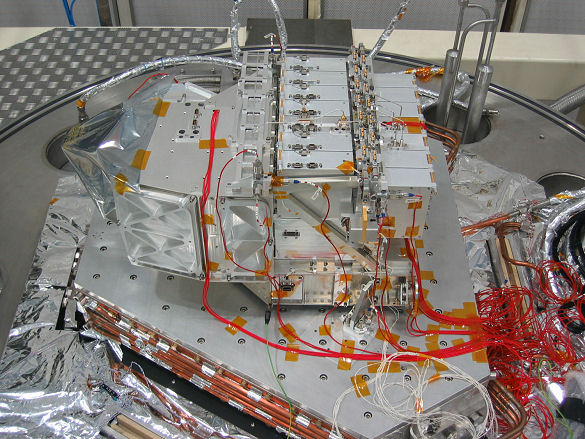





Novel Technology HIFI was more than just heterodyne receivers launched into orbit in order to overcome the low transmission of radiation through the Earth’s atmosphere at critical wavelengths (due mainly to water). The far-infrared/submillimeter range falls in between the high-performance regimes of transistors (used for microwave observations) and Si or Ge blocked impurity band (BiB) detectors (used in the mid-infrared). HIFI’s receivers represented hybrids between conventional and quantum electronics that pushed the limits of technology, employing a combination of superconductor-insulator-superconductor (SIS) and hot electron bolometer (HEB) mixing devices in the HIFI receivers to detect weak signals with very little noise (goal 3 h*nu/k). NASA-funded work at JPL on the mixing elements for the highest-frequency bands, as well as the frequency sources for these bands and components of the sources for the remaining bands, were crucial parts of these record-setting innovations, described at JPL's public HIFI technology page.
 | | Rendition of the HIFI Focal Plane Unit (FPU) |
 | | The HIFI FPU Qualifcation Module prepared for cold vibration tests, CSL (Liège), Summer 2005. |
HIFI was a very high resolution spectrometer covering 480– 1910 GHz (625–157 µm)
Principal Investigator: Frank Helmich, Netherlands Institute for Space Research
Co-Principal Investigators:
Science Drivers: Visit the HIFI Science Page at SRON.
Instrument Control Center: HIFI-ICC - operational nerve center and Project Office site at the PI institute in Groningen, NL
Properties and Sensitivities:
| Mixer Band1 Element | |||||||
| 1 SIS2 | 2 SIS3 | 3 SIS3 | 4 SIS3 | 5 SIS4 | 6 HEB5 | 7 HEB5 | |
| Frequency Coverage [GHz] | 480–636 | 626–802 | 799–961 | 949–1121 | 1108–1280 | 1426–1703 | 1696–1907 |
| Beam Sizes (Half Power Beam Width, averaged) [arcsec] | 41 | 29 | 25 | 21 | 18.5 | 14.5 | 12.5 |
| Receiver Noise (DSB6) [K] | 80–100 | 120–190 | 160–220 | 290–370 | 800–1300 | 1180–1210 | 1100–1180 |
| Flux Limit (5-sig, 1hr, R=104) [Jy/mK] | 1.7/3.9 | 3.1/6.8 | 3.0/6.7 | 5.8/13 | 15/34 | 15/34 | 13/28 |
| Line Flux Limit (5-sig, 1hr, R=104) [10−18 W m−2] | 1.0 | 2.2 | 2.7 | 6.0 | 18 | 24 | 24 |
| Line Scan (1-sig, 24hr, f=1MHz) [mK] | 5 | 11 | 15 | 26 | 60 | 140 | 117 |
Spectrometers and Resolutions:
| Wide Band Spectrometer Acousto-Optical Spectrometer | 4 x 4 GHz sections | 1 MHz (0.6 km s-1 @ 480 GHz) |
| High Resolution Spectrometer Digital Auto-Correlator | 2, 4 or 8 x 250 MHz sections (max 2 GHz bandwidth) - 550 MHz samplers | 0.14, 0.28, 0.56, 1.0 (wide band mode) MHz |
Radiometric Calibration Uncertainty: 10% baseline, 3% goal.
Hardware Fabrication: 22 institutes in 11 countries
NASA-funded hardware: NASA provided the mixers and local oscillator chains for the bands 5,6 and 7 (where 6 and 7 are two phonon-cooled HEB bands), as well as other local oscillator components for bands 1 through 4, and power amplifiers. Work was conducted at JPL.
Observing Modes: Single Target, On-the-Fly Mapping, and Spectral Scan Astronomical Observing Templates (AOTs), calibrated in modes employing position switching, dual beam switching, frequency throwing, and thermal load chopping. The observer's manual is available at the Herschel Science Center (HSC); important information on the observing mode defintions, applications, and restrictions is found in chapter 4 of the HIFI Observer’s manual. One should also read the Observing Mode Release Notes written after the checkout and performance verification phases.
Observation Planning and Proposal Submission Tools: Available in Herschel-SPOT (HSPOT), adapted from the Spitzer Planning and Observation Tool by arrangement between the NHSC, the Spitzer Science Center, and the HSC.
Data Access and Processing: The Herschel data archive is hosted at ESA’s European Space Astronomy Centre (formerly Vilspa) in Villafranca del Castillo, Spain. Users of the ISO, XMM, and IUE archives will be familiar with this location. Unlike the ISO data processing piplines, however, which were based variously on fortran, IDL, and C, the Herschel Standard Product Generation software is being implemented in Java based on development in the interactive Data Processing (DP) environment of the exportable Herschel Common Software System (HCSS). Data processing in the HCSS is also rooted in the object-oriented Java language, with Jython scripting cabilities in the user interface. The HIFI interactive DP environment is part of the HCSS, and was used during pre-launch instrument tests and then during operations by calibration scientists. The HCSS and its instrument DP environments were made available to users. A web-based resource dedicated to HIFI Data Processing can be found here.